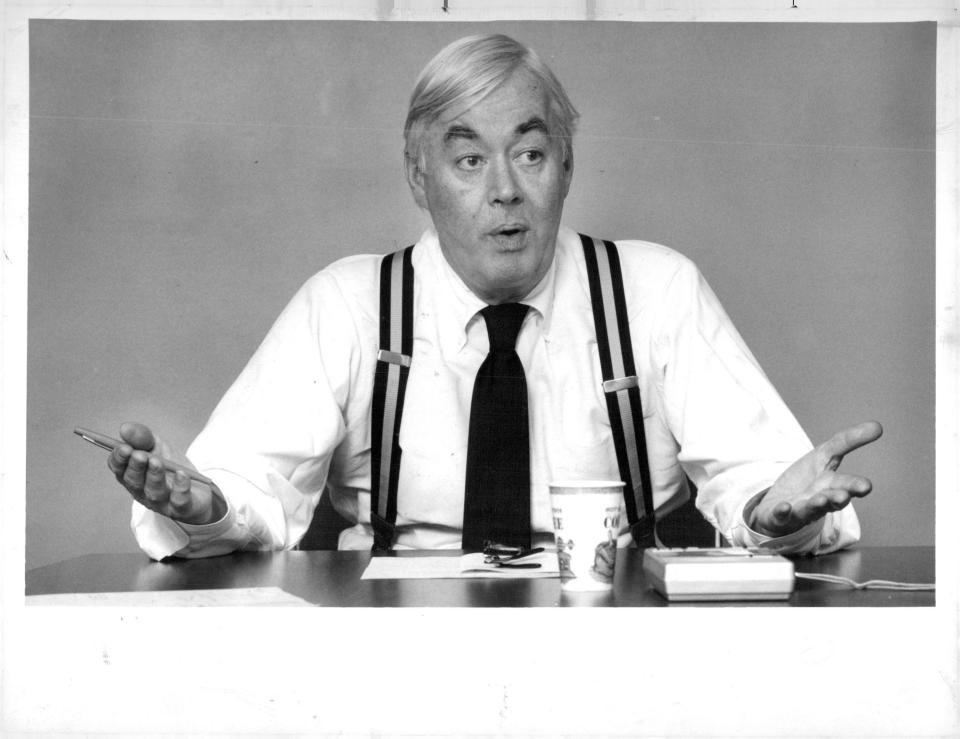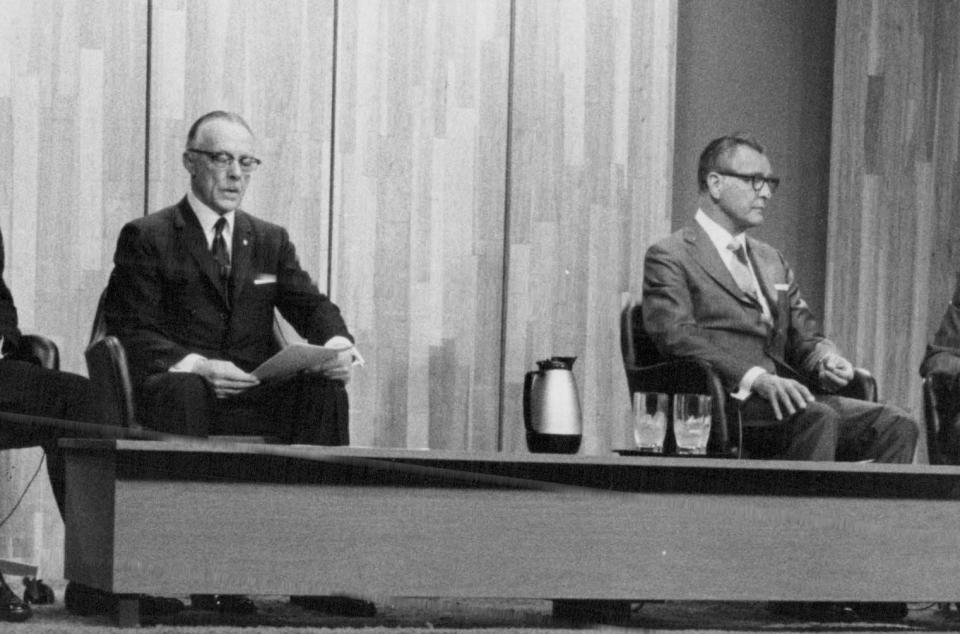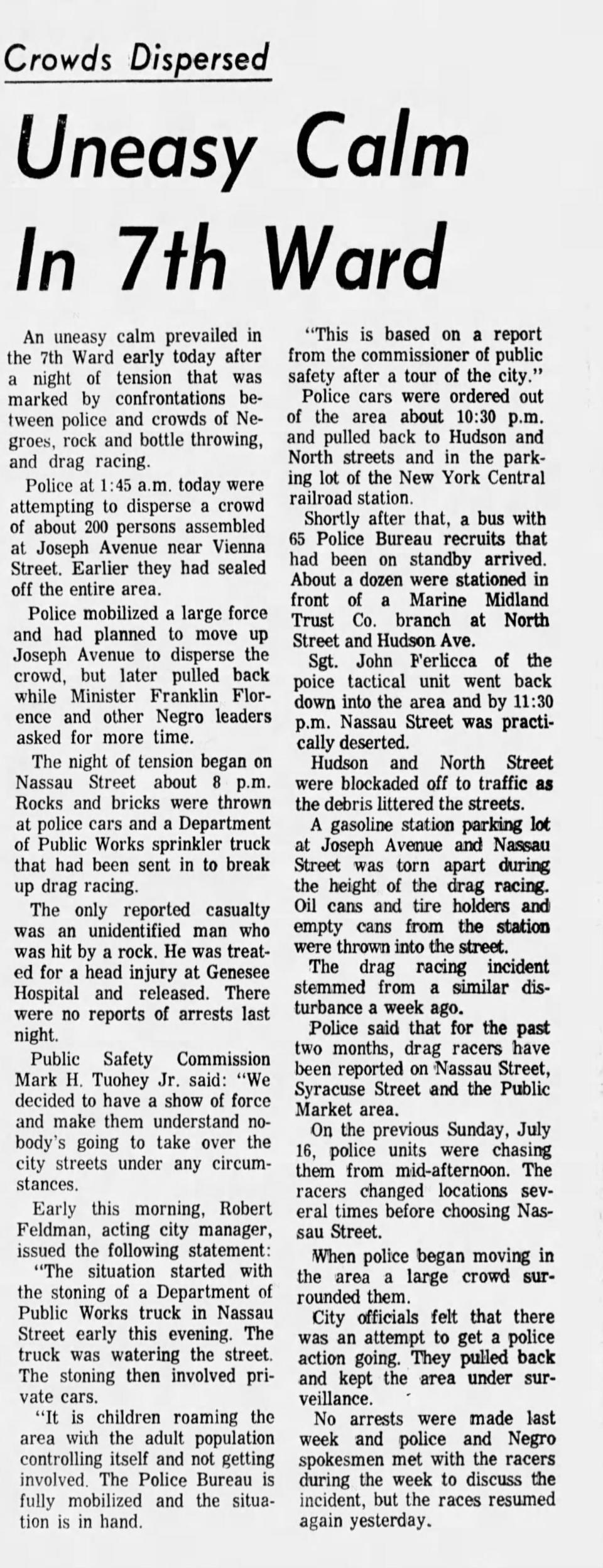A confidential Kodak document unveils new insights after the '64 uprising in Rochester
- Oops!Something went wrong.Please try again later.
It had been three years since the uprising of 1964. Whatever lessons Rochester was going to learn should have been learned.
And yet when the Eastman Kodak Co. asked a consultant for a confidential assessment of race relations in the city in the summer of 1967, the conclusion could not have been grimmer.
"The hatred of whites by Negroes is matched by the white's hatred and fear of the Negro," the report reads. "Neither race makes any attempt to control or hide its antipathy. The Negro resentment focuses on the Eastman Kodak Co. as the prime symbol of the ultimate in white power and oppression."
The 34-page draft report, written under the direction of future U.S. Sen. Daniel Patrick Moynihan, was intended as a secret document for Kodak executives. It has seldom been cited and never before published in its entirety, resting mostly undisturbed in Moynihan's papers at the Library of Congress.
It gives a startlingly frank view of race dynamics at a pivotal time in Rochester's history, describing a city even more divided than in 1964, awash in anger, fear and guns.
"A common Negro attitude was that whites deserve violence in payment for broken promises about jobs, school desegregation and improved housing," the report read. "The common white attitude was that if the ungrateful Negro steps out of line — he'll be shot."
Click here to read the full draft report.
In 'weekend of agony,' lessons to learn
An uprising or a riot? Cause or result? Inevitable or inexcusable?
No three days in Rochester's 220-year history have generated as much soul-searching and debate as the weekend of July 24-26 in 1964, 60 years ago this week. Long-simmering tension in the city's Black neighborhoods ignited into three days of chaos and violence.
Five people were killed, four of them in a helicopter crash, and nearly 900 were arrested. The property damage, mostly to white-owned businesses in the Black neighborhoods, totaled about $2 million.
White flight, driven by exclusionary federal subsidies in the suburbs and racist scare tactics in the city, was already underway and hardly needed further fuel. But for generations of white Rochesterians, that hot July weekend became convenient shorthand for a community going through, and to, hell.
"The Rochester riots pointed up sharply and fiercely the need to get specific about the race problem in this country," former Xerox executive Sol Linowitz wrote. "Perhaps in our weekend of agony here, we learned a few things which will help others avoid for them what should never have come to us."
Eastman Kodak and the city's largest institutions — the "oligarchical power structure," as the report put it — scrambled to institute job training programs, some more effective than others. Black residents were newly organized and represented, both by Franklin Florence's FIGHT and by more moderate groups like Action for a Better Community and the Urban League of Rochester.
Community leaders everywhere swore things were changing for the better.
'Riot Prediction Machine'
The report was written by an academic named Sol Chaneles but came about thanks to personal relationships between Moynihan and Kodak executives.
One Kodak leader, longtime secretary Leonard Zartman, invited Moynihan and his wife to come to Rochester during lilac season for pleasure but also business. The assignment was a confidential report on the "assimilation of the large numbers of Negroes who have come to Rochester in recent years," and in particular what role Kodak was supposed to play in the process.

The job fit neatly into Moynihan's own aspirations. A respected Washington intellectual and author of an influential 1965 report called "The Negro Family," he secured the Kodak contract for a pioneering but shadowy company called Simulmatics Corp. that sought to use Rochester as a proof of concept for its quixotic ambitions.
"The scientists of the Simulmatics Corporation acted on the proposition that if they could collect enough data about enough people and feed it into a machine, everything, one day, might be predictable," Jill Lepore wrote in "If Then," her 2020 history of the company. "(They) helped build the machine in which humanity would, by the twenty-first century, find itself trapped and tormented."
The applications in politics, finance and consumer marketing were obvious, but Simulmatics looked still farther afield. In 1967, with racial violence across the country, it claimed that advanced computer simulations in its Urban Studies division could predict the exact location and timing of racial uprisings.
The idea was a "Riot Prediction Machine," in Lepore's words, and Moynihan meant to take it for a spin in Rochester.
Long, hot summer of 1967
A six-person research team was in Rochester from July 15 to July 25, 1967, interviewing about 80 people. A secretary, Gaye Anne Himmelsbach, recalled that she spent the entire time locked in a hotel room under constant armed guard from New York State Police.
The team's work was qualitative, not quantitative, and yet after four days they confidently issued "an unqualified prediction of violence to occur about 11 p.m. on Sunday night July 23."
The prediction was not a particularly bold one: riots happened in dozens of cities across the country that weekend, most notably in Detroit, where 43 people were killed over five days. A week earlier, 26 people had been killed in fighting in Newark.
Moynihan's team called the state police and the troopers helped maintain order over the next few days. There was no riot July 23 but rather "a night of tension that was marked by confrontations between police and crowds of Negroes," the Democrat and Chronicle reported.
The following night police killed one Black man, Tommie Wright, while he drove toward a barricade on Jefferson Avenue. A later internal investigation exonerated the police.
'The situation cannot become worse'
More notable from a historical perspective is the unvarnished picture that the report gives of Rochester at a critical moment in its history.
The on-site research leader, Peter Shulman, recalled being in a room with young Black men as they made Molotov cocktails.

"What I remember the most from walking around the streets (in Black neighborhoods) was that none of them were smiling," Shulman, now 87, said in an interview. "We didn’t meet a happy person the entire time we were there. ... I went there without any preconceptions, but I came away sympathetic to their position."
The report passes along a scathing review of Rochester's social structure from the eyes of its poor Black residents — "the little people," as Chaneles said they referred to themselves.
"The 'little people' view these ghettos, whose physical boundaries are becoming increasingly rigid, as centers of sin whose existence depends largely on Kodak's implicit or explicit approval," he wrote. "(They) see the Eastman Kodak Company as being the primary agent for thwarting the possibilities for human and social development in the ghetto."
In interviews with white leaders, the Simulmatics researchers found attitudes ranging from ignorance to simmering rage. This was particularly true in the Rochester Police Department.
"One white police officer interviewed said that it is department policy to disregard the prostitution and gambling in the Negro areas," Chaneles wrote. "He stated that high departmental officials hold the Negro policemen suspect; and that highly placed white men, both Italian locals and Eastman officials, dictate police policy."
The tension was so high, the researchers concluded, that further violence not only was inevitable but in fact would be beneficial.
"Further riots can, at this point, only have a cathartic effect and will produce breathing spells between tragic outbursts," they wrote. "The situation cannot become worse."
Tensions defused
Despite the dire tone of the Simulmatics report, Rochester has not seen a reprisal of the 1964 uprising in the 60 years since. Does that mean it was wrong?
Not necessarily. Much progress was being made in 1967, most prominently at Kodak. That was the year that Franklin Florence led a protest at the company's annual shareholder meeting in New Jersey, commanding national headlines and eventually leading to a settlement on jobs creation program. That happened in June 1967, a month before the Simulmatics team came to town.
In a meeting with Kodak executives in May, Moynihan told them that his "sympathies lay with FIGHT," according to an internal memo. "Several times in the conversation I mentioned that (Saul) Alinsky is an honorable man, and that he is doing no more than he said he would do."
When Moynihan became convinced in late July that a riot was imminent, he called Gov. Nelson Rockefeller, who sent in state police.

Shulman said investigators demanded from him the names of the men he'd seen making homemade bombs earlier in the week.
"I told them we never asked those people for their names," he said. "It would have been stupid to do so. But they didn’t believe me."
A massive riot broke out in Detroit the following day, taking the focus from Rochester — and reinforcing, perhaps, the view of some of Rochester's civic and business leaders that racism and civil rights were mostly issues for other cities.
— Justin Murphy is a veteran reporter at the Democrat and Chronicle and author of "Your Children Are Very Greatly in Danger: School Segregation in Rochester, New York." Follow him on Twitter at twitter.com/CitizenMurphy or contact him at jmurphy7@gannett.com.
This article originally appeared on Rochester Democrat and Chronicle: Secret Kodak document reveals new perspectives after 1964 uprising

